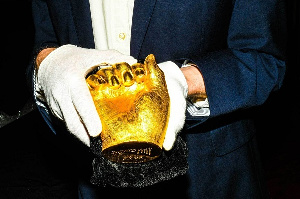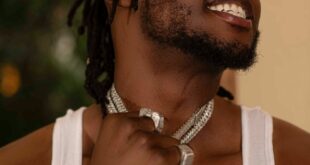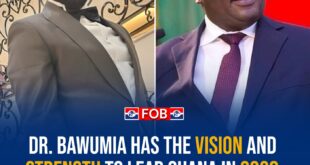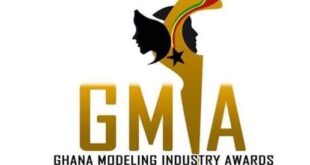In May 2003, Nelson Mandela—former South African president, winner of the Nobel Peace Prize, and hero to millions—sat down at the dinner table of his house in Johannesburg and laid his right hand, palm side down, into a lump of cold dental putty. A team of technicians from the precision-casting division of Harmony Gold Mining Co. was present to supervise, and Mandela chatted amiably with them as they worked, pausing to sip coffee with his free hand.
The silicon-based putty had been chilled to make it harden more slowly, but the men had only six minutes of malleability to work with—time they used to get the material into every wrinkle and crease, almost perfectly capturing Mandela’s fingerprints as well as the scars from his hard labor on Robben Island. Then they poured more on top to encase his knuckles and fingernails.
Harmony would use the molds from that day to create resin replicas, then casting of Mandela’s hand in 99.999% pure gold. This prototype was to be the first in a series: at least 27 gold hands, weighing 5.7 pounds to 8.8 pounds each, to mark the years of his imprisonment, followed by silver versions for each month, and finally thousands of bronze copies to mark each day.
They would be sold to raise money for the Nelson Mandela Children’s Fund, the charity to which he devoted much of his time in retirement—and serve as advertisements for Harmony’s casting expertise in the process. Throughout the making of the moldings, Mandela was “amazingly helpful, patient, and funny, and he kept everyone entertained with stories,” according to an account in the company newspaper, Harmonise.

Mandela sitting for the casting
That may well have been the happiest that Mandela ever felt about the project. Not long after the castings were made, he became concerned that too many people were profiting from “Mandela art,” a cottage industry that included selling sketches he’d purportedly drawn and putting his face on dishes, teapots, and commemorative tchotchkes.
After Mandela dispatched a team of lawyers to shut down the trade, Harmony stopped producing hands, leaving only a tiny initial batch. The project was largely forgotten.
Except, that is, by Malcolm Duncan. Then a 47-year-old auto parts entrepreneur, Duncan had met Mandela a few years before, during an event at a cancer clinic in the township of Soweto. Like many who came face to face with the legend, Duncan was overcome.
“I couldn’t talk, because he was so humble,” he recalls. “I had such a lump in my throat.” When Duncan learned about the hands, he had to have them. Not long after the castings, he managed to buy four gold examples; he’d wanted two more but couldn’t get them before the project was shut down.
Duncan says he intended to make the hands the centerpiece of a collection of Mandela memorabilia, both for personal inspiration and to show to friends and family. He describes them as objects of reverence, near-supernatural totems of Mandela’s legacy. Like secular versions of the supposed saintly relics that inspired pilgrimages in medieval Europe, the castings were the closest thing to a literal piece of South Africa’s post-apartheid hero. Not unrelatedly, Duncan also figured they’d make a good investment.
None of that came to be. Instead, the castings became Duncan’s proudest possessions but also a source of enduring distress, an almost too-neat illustration of the perils of getting what you wish for—and of the uncomfortable questions that arise when veneration meets commercial gain.
“I’ve been to hell and back with these hands,” he says. “To hell and back.”
Duncan, who has silver hair, thick black eyebrows, and a face that frequently breaks into an animated, puppyish grin, spent most of his childhood in Penge, a remote village where his father was an electrical engineer at an asbestos mine.
He completed his military service—mandatory in those days for White South Africans—in 1977, entering the workforce as the apartheid system was beginning to buckle under the weight of internal protest and economic isolation.
It was also a time of rising international interest in African culture, a trend whose commercial potential wasn’t lost on Duncan. In 1986, the same year Paul Simon released Graceland, Duncan flew to Miami with a suitcase full of masks, soapstone carvings, and wooden jewelry sourced from roadside vendors. Finding buyers was initially slow going; after weeks driving from state to state, he pulled into Los Angeles with only $43 to his name.

Mandela’s fingerprint
But Angelenos proved receptive to what he was selling, and within a week Duncan had unloaded all his items. He returned to South Africa with $4,000 in profit—hardly a fortune, but enough to help get him started. He ended up selling running boards for cars, importing them from a company in Indiana before setting up his own factory.
Duncan’s admiration for Mandela was late blooming. Like many Whites of his generation, he’d been raised to view the African National Congress, the resistance movement and political party in which Mandela was a senior leader, as something like a terrorist organization—the opinion of the apartheid government, which convicted Mandela of “sabotage” in the infamous Rivonia Trial in 1964.
But his grace when he was released from prison in 1990—pursuing reconciliation with his persecutors and laying the groundwork for a multiethnic democracy—changed Duncan’s views, and by the time Mandela became president, he was a convert.
When he happened to meet a bus driver who knew Mandela’s private secretary, it seemed like fate. Duncan got to know the secretary and negotiated with her to help fund the Soweto clinic, which Mandela was also supporting, giving him the chance to meet his hero.
Duncan wasn’t in attendance when the prototype hand went up for auction in June 2003. The sale went well, with an unidentified private buyer paying 425,000 rand, then about $46,000. Duncan made his move a few months later. The four hands he bought included a clenched fist symbolic of 1964 and a three-part set, corresponding to 1990, consisting of another fist, an outstretched hand, and a palm imprint.
Unlike the prototype, they were hollow, like chocolate Easter bunnies, to prevent excess weight from deforming their shape over time. Half the 2.7 million rand that he says he paid was to be donated via Harmony to the Children’s Fund, a condition that Duncan says won him Mandela’s blessing.
(The Children’s Fund didn’t respond to requests for comment, while the Nelson Mandela Foundation, which functions as the primary custodian of Mandela’s legacy, didn’t provide one before the deadline for this story.)
Duncan secured the hands in a bank vault, figuring he’d decide later how to display them. But attitudes about objects honoring the former president soon changed dramatically.
In 2005, Mandela filed a suit against his former lawyer, Ismail Ayob, and Ross Calder, a publisher who’d worked with Ayob on what buyers assumed was officially sanctioned Mandela art, accusing them of exploiting his image.
Mandela was 86 at the time, and the implication of the suit was clear: that the pair had been taking advantage of an increasingly frail legend. Later that same year, Mandela expanded his legal fight, going after dozens of companies selling similar paraphernalia. (The legal action against Ayob and Calder was never concluded; both denied wrongdoing.) The market for Mandela art collapsed.
For Duncan, this presented a problem. Not long after buying the hands he’d decided to relocate to Canada, spurred by a home invasion in which his 11-year-old son was held at gunpoint. He needed capital to set up an auto parts company there, and selling the hands seemed like an obvious way to obtain it.
But the controversies around Mandela art meant buyers were scarce, and anyone willing to contemplate a purchase wanted proof that Mandela had authorized their casting and sale to Duncan—assurances, in other words, that he wasn’t just another profiteer.
Duncan couldn’t offer any. He had no formal ownership papers, only metal plates that Harmony supplied and Calder signed. He had no way to get in touch with the ailing Mandela to clear things up, nor could he prove the hands were among only a few in existence.
In 2015 he thought he was near a sale—to a Saudi family he says was willing to pay $27 million—only to have it fall apart when he couldn’t produce the necessary paperwork.
With no buyer willing to write a check, Duncan was increasingly fearful that someone would steal the hands. At one point he painted them black—“I thought, if nobody knows they’re gold, who’s going to steal a hand,” he says—and buried them under his garage in Calgary.
It took Duncan years to establish the hands’ provenance to the standards expected by the international art market, just in time for a boom in a commodity that arguably has even less real-world utility than gold. In 2018 he met Len Schutzman, a former PepsiCo executive who was running a cryptocurrency startup in Waterloo, Ont., the home of the BlackBerry. The company, Arbitrade, had an unconventional pitch for investors: It would back every virtual coin it minted with physical gold. When Schutzman learned about the hands, he made Duncan an offer: $10 million for all four. The shiny appendages, Schutzman said, would become the centerpiece of an Arbitrade promotional tour and symbols of the gold-backed stability the company offered. A longer-run plan, of questionable taste even by crypto-world standards, would see the hands back a Mandela-themed digital currency.
Duncan loved the idea of putting the hands on tour. He wanted them to be seen, providing the same inspiration to others that he’d drawn from them over the years, but he didn’t have a way to display them to the public himself. And Arbitrade seemed to be good for the money, paying about $5.8 million, according to legal filings, to take possession of two hands and pay for part of a third. The others would follow once the balance was settled.
But Arbitrade’s dream of uniting crypto-enthusiasts and gold bugs was not to be, and the company ran into trouble in 2019. The hands Arbitrade had paid for went to one of its backers. Duncan was dejected. As an aesthetic matter, he’d always thought the four hands should be displayed as a set; from a financial perspective, he was also certain they’d have more value sold all together. But there seemed to be no way that would happen. And then he got a call from Arlan Ettinger.
Guernsey’s, the New York auction house Ettinger founded with his wife, Barbara Mintz, in 1975, has many of the trappings of the high-end art market: an Upper East Side address, a Rolodex of deep-pocketed buyers, and a lengthy catalog of prior sales. But it’s a rather different animal than Sotheby’s or Christie’s. Instead of Picassos and Monets, Guernsey’s specializes in memorabilia, with past auctions for items such as Jerry Garcia’s guitar, a Rolls-Royce driven by Elizabeth Taylor, and, on one unusual occasion, a house owned by Rosa Parks. (Originally on a lot in Detroit, an artist had restored and disassembled it.)
Ettinger says he heard about the hands from a lawyer involved with Arbitrade and thought they were perfect for Guernsey’s—especially if they could be reunited as a group. Duncan was supportive of the idea. So, he says, was the person who’d taken the other hands, an investor in Utah named Max Barber. (Barber didn’t respond to requests for comment.) Guernsey’s booked a room for the auction at Jazz at Lincoln Center in New York, and Duncan flew up from Austin, where he now lives, with his wife, Jacki. Ettinger informed him there were already two potential buyers. The auction, Duncan told me shortly before it began, could be a quick one.

“Why should I focus on what transpired, as long as things aren’t stolen, as long as things are what they claim to be? That’s all I care about. I do not want to know the details”
Ettinger revealed the hands to the public on March 1, the day before they would go on the block. In person they were marvels. The black paint had long since been removed. Each was set in a box made from kiaat, a rare South African wood, and lit from above, shimmering under the stage lights in every imaginable shade of gold. The detail was extraordinary, capturing calluses, wrinkles, and bones with perfect clarity.
But they also looked faintly creepy, like amputated souvenirs kept by a Bond villain. Not to mention lonely—except for Ettinger’s team and a few security guards, the room was deserted.
When I asked whether he’d advertised the sale, Ettinger responded, with barely disguised irritation, that Guernsey’s usually counts on journalists for that—a point his public-relations team had made by pushing for a “pre-auction” story that would stimulate “wide global interest.” He also bristled when I asked if the past controversies around Mandela art, or Duncan’s difficulties establishing that he’d bought the hands with Mandela’s blessing, made him hesitant about selling them. “Meaningful” works, Ettinger said, rarely made it to his auction block without some drama, whether a divorce, a soured transaction, or a family feud. “Why should I focus on what transpired, as long as things aren’t stolen, as long as things are what they claim to be?” He continued: “That’s all I care about. I do not want to know the details.”
As the day went on, only a few people turned up to view the hands. One was G. Lynn Thorpe, a lawyer and inventor—his latest project is a portable folding tray table—who was representing Barber. Thorpe took a philosophical view of the objects, describing himself as honored to be involved with a piece of Mandela history, especially as a Black man. “When Nelson Mandela went into jail, that was just a spike in all our hearts,” he said. It was a shame, he added, that other historical figures hadn’t cast their own digits in precious metal. “If Gandhi, for example, had had it done, if Jesus Christ had had it done, it’d be the holy grail.”
Thorpe wasn’t alone in ascribing profound meaning to the hands. Almost no public figure of the past 100 years attracts such unreserved adulation as Mandela, a degree of reverence usually reserved for deities or their offspring. Abby Goldman, an Upper West Side resident who stopped by the viewing toward the end of the day, couldn’t make it through a sentence without choking up. “I don’t know why I’m crying, but it’s very emotional,” she said. She lifted her own hand just above the imprint of Mandela’s palm, as though imagining what it would be like to touch him. “He represents human rights and freedom and equality,” she said. “In the current political climate it definitely resonates.” Another onlooker, Brienna McClarin, had come during a break in her waitressing shift at a bar across the hall. “I’m getting chills,” she said when she saw the hands. Neither of them, however, was about to put down $10 million or more—the number Duncan hoped to get for the set.
As the viewing closed, a Guernsey’s staffer pulled on white gloves and carefully covered each hand in bubble wrap, tearing off lengths of tape with his teeth. For some reason he had only three black pouches, so the fourth hand was crammed into a FedEx envelope and loaded with the others into a sturdy suitcase. Ettinger wheeled it away.
The next morning, Duncan texted to say he was talking to a prospective buyer “from the Middle East. Might be massive.” The auction was scheduled for that evening, with the hands still available for viewing until then. As the day wore on with few people turning up, Ettinger snapped that having a reporter and photographer “just sitting there” was scaring off business. He later apologized, pivoting to a story about an auction in which he’d sold the entire contents of an ocean liner.
At dinner in a restaurant a few floors down, Duncan seemed to be preparing himself for the possibility that the hands wouldn’t sell. It might even be a blessing in disguise, he speculated. Why not buy back the whole set and find a celebrity endorser to give them the prominence they deserve? “You’ve got Bono who loves Mandela. You’ve got Elton John who loves Mandela,” he said. “Why not Bill Clinton?”
With 30 minutes to go, the room finally started filling up. Ettinger’s aides took up their positions, with two deputies at desks prepared for phone and online bids. Thorpe was back, along with an Orthodox rabbi, numerous friends and associates of Barber, and Faye Wattleton, the former president of the Planned Parenthood Federation of America, who’d been helping Ettinger drum up buyers. “I had expected that there would be greater interest in them from wealthy African-Americans I reached out to,” Wattleton said. She noted it was difficult to understand the hands’ impact without seeing them in the flesh, as it were. “What would you say if somebody called you up and asked, ‘Would you give me $12 million for some gold hands of Nelson Mandela?’?”
At 7:40 p.m., Ettinger asked everyone to take their seat. He opened at $12 million for all four hands. No takers. He dropped the ask to $10 million, then $8 million, then $7.5 million. “I’m not allowed to, nor should I, go any lower than that, so I’ll hold another minute.” Silence.
It was time for plan B: selling the hands one at a time, with the 1964 fist the first to go. This time Ettinger started at $4 million, quickly dropping from there. “3.5?…?3?…?2.5?…?2.25.” One of his staff cut in to say he had a remote bid for $1 million, but Ettinger rejected it as too low. He soon withdrew the fist, though the same anonymous bidder agreed to pay $2.3 million for the impression of Mandela’s palm. When the third hand came up, the staffer said he had a $1 million offer from the same buyer. Trying to push up the number, Ettinger turned to another aide with a potential buyer on the line.
“Susan, tell your bidder there are only two hands left.”
“I’m supposed to tell you there are only two hands left.”
“Tell him life is short.”
“Arlan says ‘life is short.’?”
No luck. That hand, too, had to be withdrawn. The fourth went to the same buyer as the second, for $2.25 million. The whole auction was over in 15 minutes. In the front row, Jacki had her hand on Duncan’s knee. “I hope he gets what he needs,” she said softly.
The room began to empty out, but after a few minutes it became apparent that Ettinger wasn’t finished. He was still on the phone, seemingly with the two-hand buyer. Suddenly he put down the receiver to make an announcement: The buyer had agreed to take the remaining hands, for a total of $9 million. Duncan’s face lit up; Guernsey’s staffers shook their heads in disbelief.
Ettinger said he needed to sit down “before I collapse.” The buyer wished to remain anonymous, Ettinger said, offering an unconvincing explanation of why this person would pay $9 million for all four when they’d been available at the start of the auction for $7.5 million. “To try to imagine what they’re thinking is impossible,” Ettinger offered. “You get into a mood, you get things happening. I can’t say why.”
“I knew it was a safe investment, but I admired Mandela passionately. If Mandela had asked me to go to war, without thinking I would have done what he asked”
Duncan and Jacki flew back to Austin the next day, assured by Guernsey’s that the deal would be finalized soon. But then, nothing. Ettinger told Duncan the mystery buyer needed more time to gather the funds because of the financial turmoil of the coronavirus pandemic, and a May 1 deadline to make the transfer came and went.
A few days later, Duncan received an email from Ettinger with what seemed like great news: The buyer would be willing to throw in another $1 million if he could have some time to get the money together. Duncan was still optimistic. “Let’s give him the benefit of the doubt,” he said. “The buyer must really want it.”
A week afterward there was still no sign of the cash, and Duncan was getting anxious. It all felt like déjà vu, a version of the check-is-in-the-mail assurances he’d received right before the Arbitrade deal fell through. He’d asked Ettinger repeatedly to connect him with the buyer directly, to no avail. He was starting to wonder, he said, whether there was really anyone on the other side of the phone at the auction. In a mid-July interview, Ettinger rejected that speculation, saying he’d been in regular contact with the buyer, who “was hit broadside, as many, many people have been, by the virus” and its effects. “The sale is still live,” he said. “We’re hoping for the best and remain optimistic.”
Despite Duncan’s difficulty closing a deal, and his insistence that the hands deserve to be seen by as many people as possible, he says he has no plans to donate them to a museum or charity. For one thing, he’s counting on the cash to expand his latest venture, a company that converts shipping containers into off-grid shelters for disaster zones.
And he says he sees no contradiction between admiring Mandela and seeking a profit from selling the hands—as even the most dedicated collector might, if the opportunity arose. “I knew it was a safe investment, but I admired Mandela passionately,” he said of his purchase. “If Mandela had asked me to go to war, without thinking I would have done what he asked.”
Meanwhile, Duncan is still convinced that his big score is on its way. Like a rubber ball, he’s unsquashable. In June he said that an old friend had put him in touch with a possible buyer in Italy, in case the Guernsey’s sale never happens. What did he know about this new lead? “Absolutely nothing.” He’d been on a conference call with someone who said he was representing the Italian, but no more than that. “We expect a call from him any day now.” —With Michael Cohen
Source: bloomberg.com
 Home Of Ghana News Ghana News, Entertainment And More
Home Of Ghana News Ghana News, Entertainment And More





